The flag
The New South Wales state flag has a blue background and consists of 2 elements; the Union Jack in the upper left corner and the badge of New South Wales on the right side. The first badge of the colony of New South Wales, authorised in 1869, was simply the red cross of St George on a silver (white) field.
The colour references for the New South Wales state flag are:
- Red: PANTONE® 485,
- Blue: PANTONE® 2758, and
- Gold: PANTONE® 123.
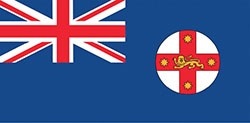
The State Arms
The New South Wales State Arms was granted by King Edward VII in 1906. On the New South Wales State Arms, a lion and kangaroo support the shield on which the old state badge of the colony appears. A golden fleece and sheaves of wheat symbolise the greatest achievements of New South Wales’ agricultural industries of the time. The crest above the shield is of the rising sun which represents the newly rising country, and rests on a wreath of silver (white) and blue which represent the state’s livery colours.
Motto on Arms
Reflecting the rising sun crest of New South Wales, the state’s Latin motto is:
Orta recens quam pura nites: “Newly risen how brightly you shine”.

The badge
The current badge on the state flag was announced by the then Governor of New South Wales, Sir Hercules George Robert Robinson, on 15 February 1876 and has been used since it was proclaimed in the New South Wales Gazette on 18 February 1876. It shows the golden lion of England in the centre of the red cross of St George on a silver (white) background.
The cross also bears 4 eight-pointed stars, one on each arm, which represent the Southern Cross. The golden lion and cross of St George reflect the British heritage of the first European settlers. The cross of St George is also the traditional badge of the British Royal Navy.
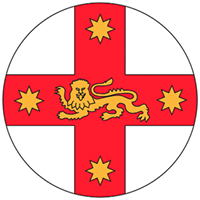
The floral emblem
The waratah
The New South Wales waratah has been the floral emblem of New South Wales since 1962. Brilliantly coloured waratah blooms can be seen for miles. No wonder the New South Wales waratah was given the Greek botanical name of telopos, meaning seen from afar. There are 4 other waratah species in Australia, occurring from Tasmania to northern New South Wales.
The waratah flower is made up of a pincushion arrangement of small flowers, surrounded by bright red bracts, with blooms growing up to 12 centimetres wide. The flowers appear on tall bushes with stiff, long, saw tooth leaves. While the flowers are pollinated by the many native birds which perch on the blossoms to sip the nectar, waratahs are notoriously hard to cultivate.
Unfortunately, no one now knows the exact meaning of the Aboriginal name waratah, however it comes from the language of the Eora people and appears in a number of First Nations Australians Dreaming Stories across New South Wales nations.
In an Aboriginal Dreaming Story, Wamili, the great hunter, loved the nectar of the waratah. When he was struck blind by lightning, the Kwinis, tiny bush spirits, made the central pincushion flowers of the waratah more rigid so Wamili could find the bloom by touch.
You can find waratahs in the Blue Mountains, west of Sydney, and a rare breed of white waratahs can be found only in the southern highlands; you can’t pick them as they are protected by the state. The waratah was adopted into the New South Wales Government logo and brand in 2009 which features prominently and consistently across government communications and within the community.
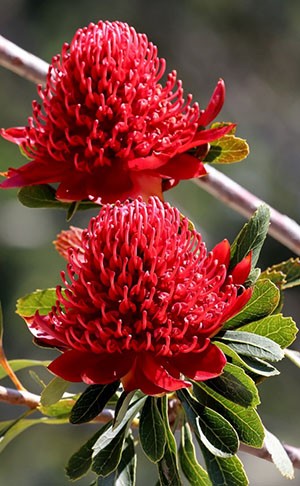
The animal emblems
The laughing kookaburra
There are 10 species of kingfishers in Australia and the largest kingfisher in the world is the laughing kookaburra, which has been the bird emblem of New South Wales since 1971. Kookaburras have brown and white feathers to help it blend in with the environment, large heads, a distinctive dark brown stripe which runs around each eye and long beaks that can grow up to 10 centimetres long. They can measure up to 46 centimetres from the tip of its beak to the end of its tail.
With a territorial call like fiendish laughter, kookaburras wake people up throughout eastern Australia.
Its other names are the “bushman’s clock” and the “laughing jackass”, since it sounds a little like the braying of a male donkey. Kookaburras live mainly in the eucalypt forests of eastern Australia but have adapted well to life in towns and suburbs. Kookaburras do not need to drink any water, getting enough water from the food they eat. Their diet includes lizards, small snakes and insects, and unfortunately on occasion can also include chicks and ducklings on farms and fish in garden ponds.
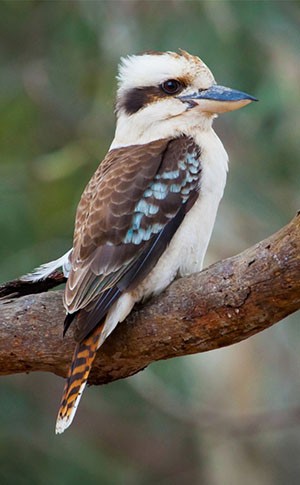
The platypus
The platypus is a mammal which lives in burrows by rivers in eastern Australia and became the faunal emblem for New South Wales in 1971.
The platypus is one of the world’s strangest creatures. It is one of only 2 monotremes, or egg-laying mammals, on earth - the other is the echidna, the spiny anteater. The female platypus feeds milk to its grub-like young but since the mothers have no nipples, their young uses its rubbery, long lips to suck milk from fur on the mother’s belly for its first 4 months of life.
The adult males have a poison spur on the heel of each hind foot for combat against other males; the poison is extremely painful to humans and produces symptoms similar to a snakebite.
The platypus is an agile swimmer with a big appetite. It finds its food mainly by nosing around in the beds of streams and rivers. Each day, it eats nearly its own weight in food: yabbies, fish, frogs, shellfish, tadpoles and earthworms.
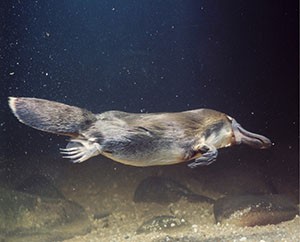
The fish emblem
The eastern blue groper
An inquisitive and friendly fish, the eastern blue groper is endemic to Australia and was proclaimed in 1998 as the fish emblem of New South Wales, the first state to identify a fish as a state emblem.
The eastern blue groper is a species of wrasse and, once endangered, has made a strong recovery from over-fishing as a result of laws of the state, limiting exploitation of the species.
Strongly territorial, inhabiting rocky reefs, river estuaries and sea grass beds along the New South Wales coastline, it is very responsive to contact with humans. It’s no wonder it is a favourite of the diving fraternity who have found the fish willing to accept hand feeding from divers and to welcome close encounters of the submarine kind.
This stout bodied species has peg-like teeth, heavy scales, a large tail and thick lips and can grow to over a meter in length and weigh up to 25 kilograms. Eastern blue gropers are born females and transition around the time it reaches 50 centimetres in length into males. Though the eastern blue groper is in no danger from spearfishing, it is likely to be snapped by underwater photographers keen to capture the beautiful deep navy to cobalt blue of the male fish, or the green brown to golden colour of the female.
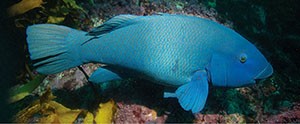
The gemstone emblem
The black opal
The black opal was proclaimed in 2008 as an emblem of New South Wales. It is the rarest and most valuable type of opal, at times even reaching carat prices rivalling the best diamonds. It is called black opal because it has a dark grey to black background hosting a kaleidoscope of colours.
Australia produces over 90 per cent of the world’s supply of precious opal. The major opal producing areas in New South Wales are Lightning Ridge and White Cliffs. Over 99 per cent of the most valuable black opal comes from only 2 localities – Lightning Ridge and Mintabie in South Australia.
Opals are usually found in solid rock containing minerals in the center (nodules) or formed in thin layers in the strata (seams) but sometimes they emerge in fossils. The area around Lightning Ridge was part of an inland sea 100 million years ago home to many animals, including birds and fish. As their remains sank into the mud, some transformed into opalised fossils.
Australia is the only part of the world where opalised animal and plant fossils have been found. The most famous opalised fossil is Eric the Pliosaur, who can be found in Sydney’s Australian Museum.
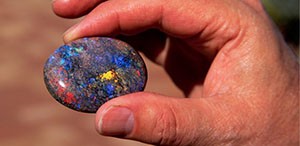
The fossil emblem
Magdageria fairfaxi
The 370 million year old Magdageria fairfaxi was proclaimed in 2015 as the New South Wales state fossil emblem and is one of the largest fish fossils in the world and unique to New South Wales. The predatory fish was a large, air-breathing lobe-finned fish that grew up to 1.7 metres long and had powerful jaws lined with many large fangs from the Canowindra Fish Bed in central New South Wales.
The Magdageria fairfaxi belongs to the Tetrapodomorphs, this clade of vertebrates exhibited the transition from fins to limbs, and from using gills in water to breathing air. They are significant because they are considered ancestors of all land vertebrates including humans.
The historic paleontological dig of 1993 was led by Doctor Alex Ritchie, a research scientist from the Australian Museum, and remains a significant paleontological site. It represents a mass grave of fish trapped in a shrinking billabong. The dead fish were rapidly covered by sediments that preserved them with little disturbance, ensuring they remained complete and in excellent condition upon excavation.
Over 3,000 other fossil specimens were discovered with 8 new species and 4 genera known only to New South Wales. The Magdageria fairfaxi is the largest fish discovered at the site and the fossil was affectionately nicknamed Fred to honour Fred Fewings who was the skilled operator of the 22 tonne excavator. You can visit the Age of Fishes Museum in Canowindra that displays many hundreds of freshwater fish fossils from the Devonian Era that were unearthed, including a life-size three-dimensional model of the Magdageria fairfaxi.

For further information on the symbols of New South Wales, please contact:
New South Wales Protocol
Department of Premier and Cabinet
GPO Box 5341
Sydney NSW 2001
Phone: 02 9228 5555
Email: protocol@dpc.nsw.gov.au
